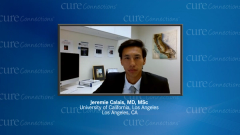
Clinical Considerations Related to Lutetium 177– PSMA-617 Treatment in mCRPC
Dr Jeremie Calais shares some clinical pearls for lutetium-177 PSMA 617 and how this therapy has changed the treatment landscape for patients with metastatic castration resistant prostate cancer (mCRPC).
Episodes in this series

Alicia Morgans, MD: Jeremie, I’d love to hear you give a little more information to the caregivers and patients. What should everyone be aware of before, during and after treatment with lutetium-PSMA-617?
Jeremie Calais, MD, MSc: First, it’s a drug that is injected. It’s a radioactive drug, but the way we administer it is via an IV [intravenous] line. Usually, patients will sit in a chair. It’s a bit like an infusion chair and similar to a chemotherapy setting. Patients will stay in the ward for 2to 3 hours where the treatment is administered at intervals of 30 minutes. Patients are prepared with an IV line, hydration, and some antiemetic treatments. We observe them, make sure everything is fine, and then the patient uses the restroom to void the first urine, which is the most radioactive. We measure the radioactivity to make sure that the patient is under the threshold that would require a hospital stay. As soon as we have that [radioactivity level], [the] patient can go home and be released from the hospital. It’s pretty straightforward in the hospital. It’s a 2 or 3-hour appointment. It’s done through an IV line and you sit in a chair.
The second thing is the time interval. Usually, you can get 4 to 6 cycles of therapy, depending on the setting. And you get an interval between each cycle of 6 to 8 weeks, also depending on the setting. So 1 cycle every 6 to 8 weeks, and this you do 4 to 6 times. It takes about 6 months, something like that, during which there will be some back and forth to the nuclear medicine clinic for these injections.
Then in terms of radiation safety, and for the people around the patients, this is most important during the first days following the administration of the treatment, that’s when the patient is the most radioactive. The drug will go into the patient, circulate through the body, and most of it will go to the target lesions and stay there, that’s what we want. It will be locked and trapped there and continuously deliver radiation just around where it has been emitted. Then there is the rest that is not used or eliminated by the kidneys. This will be eliminated during the first two or three days. That’s when the patient is a bit radioactive for the surrounding people because there is a tiny part that is emitting different types of radiation that goes out of the body. It’s a low dose of radiation, more or less similar to an X-ray. If you stay very close to a patient for consecutive hours, you could get a little bit of low-dose radiation.
I usually take the example of sleeping in the same bed the night just after the administration of the treatment. If you sleep for 8 consecutive hours side by side, very close, you may get an amount of radiation similar to a CT [computed tomography] scan or an X-ray. It will not create real damage, but you don’t want to do a CT scan or an X-ray if there is no medical reason. It’s just a common sense rule, as a measure of precaution.
Radiation, how does it work? The closer you are, the more you’ll get. And the longer you stay, the more you’ll get. The basic protection rule is to keep 2 or 3 feet of distance, and already there will be almost no radiation from that standpoint. If you have to hug, or if you have to stay close, stay 5, 10, 30 minutes, that’s OK. You just don’t want to stay 12 hours consecutively, side by side. The more important thing is the person. Younger children and fetuses are more sensitive to radiation, so you stay away from kids, pregnant women and babies during the first 2 to 3 days following the administration. Again, it will probably not harm them, but you just don’t want to expose them for no reason. It’s an easy precaution to keep some distance for 2 to 3 days. That’s pretty much it.
Alicia Morgans, MD: That’s extremely practical advice, thank you. I wonder how you follow patients for response to treatment? And if you could comment, you and Dr Rettig work together very closely, do you both follow the patient for response? How do you manage that, one of you, the other? Who does that?
Jeremie Calais, MD, MSc: That’s a good question. I think the way you can assess the efficacy and the toxicity of treatment is by talking with the patient. Ask how he’s feeling, his level of activity, and if he’s feeling better. If he had pain, has that pain improved? Then you have the PSA [prostate-specific antigen], of course, and then you have the imaging. For imaging, you can use conventional radiography with a CT bone scan, and also now more and more a PSMA PET [positron emission tomography]-CT. You will use all these parameters, again, to put that in your computer brain. as Dr Rettig says, and finally, decide if a patient is benefiting.
I have some stories where the PSA doesn’t go down, there is a clear progression on the images, but the patient is feeling much better. In that case, even if you have signs of progression by some kind of test but the patient is reporting feeling better, then there is maybe a no better therapeutic option for them at the moment, so we continue to treat these patients. And they have been grateful for that and reported some bone pain improvements, for example. That’s the way we monitor response to treatment. I think after 2or 3 cycles, you can get a good idea if the patient is benefiting. Quite frequently, after 2 or 3 cycles, we stop because the patient doesn’t necessarily need the full 6 cycles to get the benefit. Let’s say the first 2cycles are the most important, and if we will see patient is benefiting, sometimes we have this nice PSA decrease over time.
Who is performing the treatment? I think this will depend on the local setting. Here at UCLA [University of California, Los Angeles], we have strong nuclear medicine clinical research programs, so we were here using these agents since the beginning. There is nice communication; it’s a nice network. For me, it’s very enjoyable to have this multidisciplinary approach. I communicate a lot with Matt, of course, and it’s always a pleasure with our radiation oncologist colleagues as well. We, as nuclear medicine physicians, as well as the nuclear medicine physician team, would report the main findings to the medical oncology team, Dr Rettig, and ask, “What do you want to do? What do you advise us to do?” In the end, Dr Rettig will probably make the final call. We filter the first set of information about how the patient is feeling, and if there are some test results we need to report, and then in collaboration, in coordination with the medical oncology team, we will report that and make a decision on what to do.
Alicia Morgans, MD: I think that’s great. It really speaks to the multidisciplinary approach. I imagine not every center will be set up quite like that, but it’s wonderful that you have that collaboration. Do you have any comments on that, Matt?
Matthew B. Rettig, MD: I totally agree. I think patients are fortunate to be able to go to a place where so many different specialties are working together and bringing their expertise to the table for the patient. During radionuclide therapy, during the lutetium PSMA, I do co-follow the patients. I typically see them perhaps not as often as Jeremie while they are receiving radionuclide therapy, and I also will be communicating with Jeremie, as he indicated. I want to emphasize what Jeremie said about how we follow patients. There are really just 3 things that we can follow. It’s pretty simple: how you’re feeling, so you’re symptoms; your PSA; and your scans.
One thing that’s important that Jeremie already alluded to is that sometimes these 3 factors that we use to follow patients don’t go in the same direction at the same time. A lot of the time, the PSA does not track well with the scans. So sometimes a PSA can be going up, and the scans are looking a lot better. I think that’s really important for patients to keep in mind. Because, of course, from the outset, patients and their doctors are so PSA focused. But as the disease advances, what we see are these discrepancies between how they’re feeling, the PSA, and the scans. It’s important to work with your doctor to decide what is the best next step. Is the treatment working, or do we have to make a change?
Alicia Morgans, MD: I would agree with that. I certainly have patients where the PSA is going up, initially at least. But then I started to see other things, like alkaline phosphatase coming down, and patients feeling really well, and scans suggest that there’s a benefit. There’s some literature on this, some case series that I looked to when I saw this. And I said, I just want to reassure myself that this is what I think it is, it’s just a disconnect, but the patient’s really benefiting. So you are not alone. And if you have a big series, you could put it out there in the literature because we would all benefit from that. That’s a really important message, I think, as people are using these agents.
Transcript edited for clarity.








